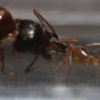Edited by noebl1, April 17 2016 - 12:23 PM.
- Formiculture.com
- Forums
- Gallery
- Members
- Member Map
- Chat


Best Answer Runner12 , April 25 2016 - 8:09 AM
It's Camponotus americanus, subbarbatus is smaller than that. It has a lot of color variation, some are light enough to almost resemble castaneus, some are much darker like yours
Go to the full post 
Edited by noebl1, April 17 2016 - 12:23 PM.
I know this is Camponotus but I don't know much about them beyond that.
Currently Keeping:
Trachymyrmex septentrionalis
Pheidole pilifera
Forelius sp. (Monogynous, bicolored) "Midwestern Forelius"
Crematogaster cerasi
Pheidole bicarinata
Aphaenogaster rudis
Camponotus chromaiodes
Formica sp. (microgena species)
Nylanderia cf. arenivega
Thanks for the reply! Wondering if Camponotus castaneus?
Thanks for the reply! Wondering if Camponotus castaneus?
I am pretty sure that is the ID but without better lighting I am not sure.
Currently Keeping:
Trachymyrmex septentrionalis
Pheidole pilifera
Forelius sp. (Monogynous, bicolored) "Midwestern Forelius"
Crematogaster cerasi
Pheidole bicarinata
Aphaenogaster rudis
Camponotus chromaiodes
Formica sp. (microgena species)
Nylanderia cf. arenivega
Thanks for the reply! Wondering if Camponotus castaneus?
I am pretty sure that is the ID but without better lighting I am not sure.
See if I can get a good shot...
Or maybe a Camponotus americanus? : Their gasters were very yellowy in the sun... haven't noticed this species really here before. Typically around here a LOT of camponotus pennsylvanicus which tend to invade houses ![]()
If you take the same pictures on top of something dark, you would see a lot more color and detail on the ants.
Edited by drtrmiller, April 17 2016 - 1:45 PM.
Ok, third times the charm with pics? Able to refocus the macro a bit and used a dark background (thanks for the tip):
Edited by noebl1, April 17 2016 - 1:48 PM.
Banding on gaster is very subtle (she's a lot darker than the workers):
I don't think this is Camponotus castaneus and I don't think it is Camponotus subbarbatus either. I have no idea what species this is.
Currently Keeping:
Trachymyrmex septentrionalis
Pheidole pilifera
Forelius sp. (Monogynous, bicolored) "Midwestern Forelius"
Crematogaster cerasi
Pheidole bicarinata
Aphaenogaster rudis
Camponotus chromaiodes
Formica sp. (microgena species)
Nylanderia cf. arenivega
Based on some photos and videos online, starting to lean on Camponotus americanus, but definitely not an expert.
Edited by Runner12, April 25 2016 - 8:10 AM.
0 members, 0 guests, 0 anonymous users